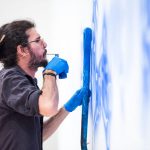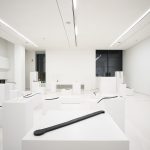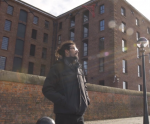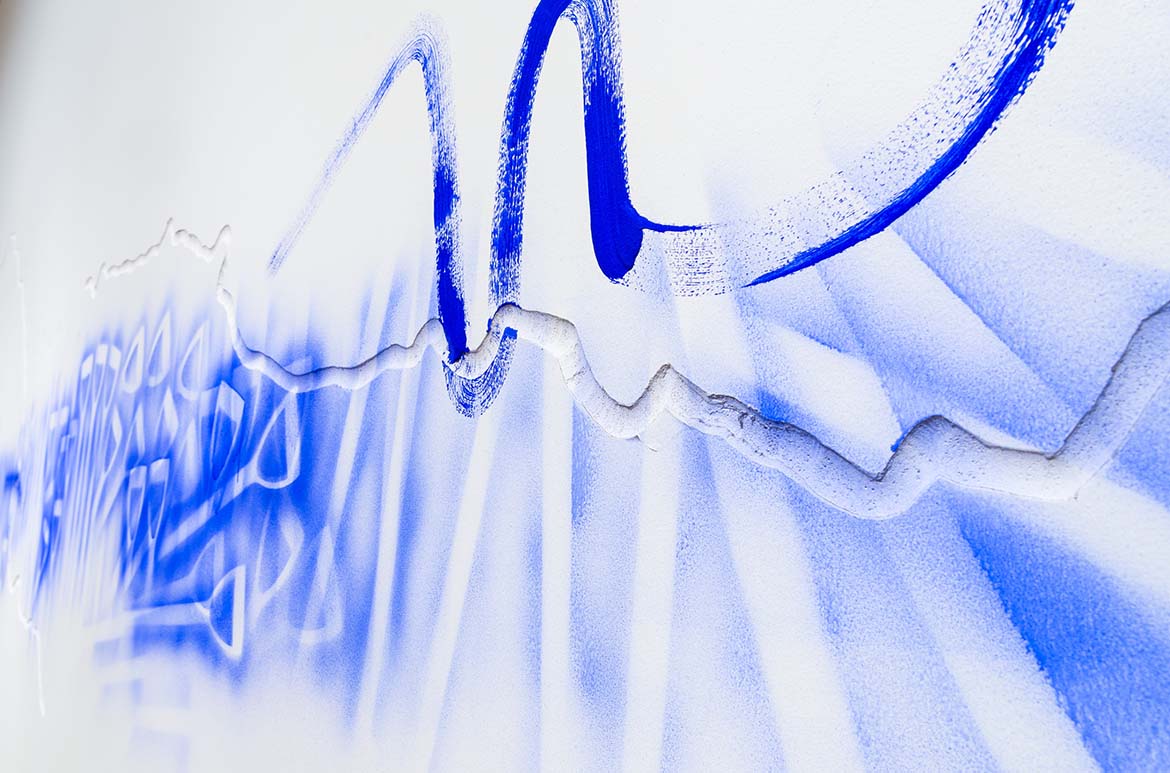 Queensland College of ArtPhD candidate Dale Harding has unveiled a stunning new work at the Tate Liverpool, as part of the tenth Liverpool Biennial.
Queensland College of ArtPhD candidate Dale Harding has unveiled a stunning new work at the Tate Liverpool, as part of the tenth Liverpool Biennial.
Dale joins more than 40 artists from 22 countries at the UK’s largest contemporary art festival, which opened over the weekend and attracts more than a million visitors during its 15 week run.
Dale was commissioned to create a stunning wall composition at the Tate Liverpool, as part of a group exhibition of First Nations and Aboriginal artists.
The large-scale mural has garnered rave reviews, with The Sunday Times singling it out for mention, calling it “a striking piece… inspired by the rock art of his ancestors”.
 Dale created the piece by by blowing colour on to the walls of the gallery, using a vibrant ultramarine pigment in place of traditional rock ochres. The blue pigment is made from a powdered laundry detergent, Reckitt’s Blue, which was produced in the UK and used across the colonial frontier in the late 19th century.
Dale created the piece by by blowing colour on to the walls of the gallery, using a vibrant ultramarine pigment in place of traditional rock ochres. The blue pigment is made from a powdered laundry detergent, Reckitt’s Blue, which was produced in the UK and used across the colonial frontier in the late 19th century.
The technique was originally inspired by rock art from Carnarvon Gorge, where Dale’s Bidjara ancestors created a series of stunning rock artworks.
Dale was born in the Central Queensland town of Moranbah and is a descendant of the Bidjara, Ghungalu and Garingbal people.
As part of his PhD, Dale spent 18 months cataloguing Carnvarvon’s rock art, and has produced a series of works that reinterpret certain motifs using modern materials like silicon, gold leaf and pigment.
“I spent a lot of time out at Carnarvon growing up, and I still go out there at least five or six times a year,” he says.
“I feel a connection to the country and a sense of responsibility.
“I was passionate about interacting with the history, of taking the art and seeing how I could use it to tell my perspective.”
Dale’s work at the Liverpool Biennial will form a major part of his PhD, which examines the links between the visual and spoken language of Indigenous Australians.
“As a researcher I want to show people that the rock panels out in places like Carnarvon were conscious artistic compositions, not just some remnants left over from a primitive civilisation,” he says.
“There is no beginning or end to the narrative — my people haven’t gone anywhere, and I see the art I’m making now as part of the same body of work.”
 Dale said presenting his work at exhibitions like the Liverpool Biennial and Documenta was “an amazing experience”.
Dale said presenting his work at exhibitions like the Liverpool Biennial and Documenta was “an amazing experience”.
“To me, there is no pressure — making art is a great joy, a constant joy.”
Dale is an alumnus of the QCA’s unique Bachelor of Contemporary Australian Indigenous Art, graduating with honours in 2013, and he credits the course with connecting him to the contemporary Indigenous art scene.
“I have been creating art since I was a kid, but the course helped me formalise a lot of the processes, and introduced me to great artists like Richard Bell, Gordon Bennett and Judy Watson.”
Dale’s pieces have been exhibited in galleries across Australia, including GOMA, the National Gallery of Australia, Museum of Contemporary Art and the Art Gallery of NSW.
 QCA Director Professor Derrick Cherrie said Dale’s selection for the Liverpool Biennial was “a major coup”.
QCA Director Professor Derrick Cherrie said Dale’s selection for the Liverpool Biennial was “a major coup”.
“To be selected for an event like this is an outstanding achievement, and is recognition on the global stage of the unique artistic voices emerging from Australia,” he said.
“The Liverpool Biennial is one of the most prestigious events on the international art calendar, and Dale’s work at the Tate will be seen by millions of visitors from around the world.
“The success enjoyed by our students and alumni reflects the calibre of our cohort and faculty here at the QCA.”
The tenth Liverpool Biennial: Beautiful World, Where are You? runs from 14 July-28 October.
